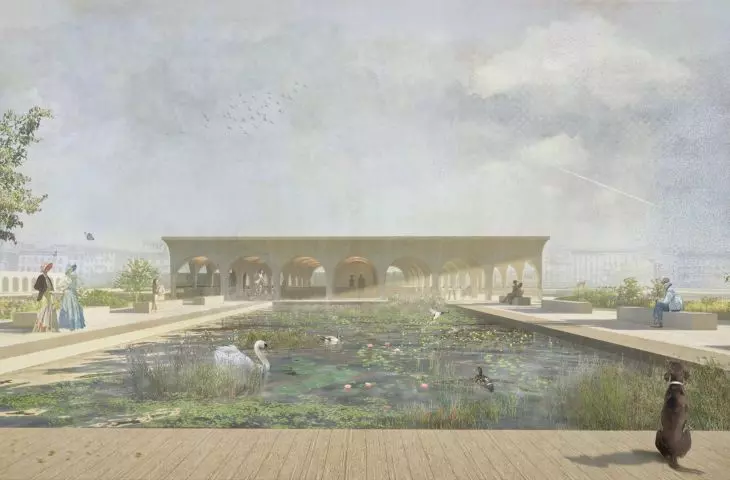{A student at the Academy of Fine Arts in Gdansk, Poland, received First Prize in the international competition "Crested - Waterfront pavilion design challenge near river Arno" organized by the UNI platform. According to the winner, "Grid of Agreement" is a design for a green oasis on the waterfront of the Florence river, which is a metaphor for the space where man reconnects with nature.
The challenge of the "Crested" competition was to design a pavilion and arrange a section of the Arno River waterfront in Florence. The organizers were looking for a proposal to give new functions to the waterfront - Terzo Giardino. It was necessary to design a pavilion dedicated to the chosen program and to refer to the context of the water, and the historic center of Florence. The revitalization of the currently neglected area could involve artistic and recreational interventions, dedicated to residents and tourists. Participants were also to take care of aesthetics and functionality, creating open, semi-open and closed spaces, and keep the environment in mind.
"Grid of Agreement" project in Florence
© Oliwia Karapuda
project from Poland the best!
The works submitted from all over the world were judged by a jury consisting of Sarah Becchio, Paolo Borghino, Paolo Panetto and Francesco Loschi. The jury decided to award the Grand Prize and five honorable mentions. An Audience Award was also given.
The winner was the project "Grid of Agreement" by Olivia Karapuda, made under the direction of Marta Koniczuk as part of the course Elements of Scenographic Design in Interior Architecture at the Academy of Fine Arts in Gdansk.
landscaping
© Oliwia Karapuda
The project concerns the revival of the ecosystem on the waterfront and the Arno River in Florence, Italy. My goal was to create a green space, an "oasis" in a crowded city. Currently, Terzo Giardino is a neglected wetland without favorable conditions for plants. The potential of this place gives us the opportunity to create a multifunctional space for residents as well as tourists. I arranged the space and enclosed it in rectangles, creating a grid of four rows with different areas. The layout slowly emerges from the natural greenery and similarly disappears into the river at the other end of the land. I designed open and semi-open spaces and a focal point - the tea pavilion. My concept proposes new solutions for the space, such as piers with boats for group cruises or independent excursions," says the author.
View from the Arno River
© Oliwia Karapuda
restoring the ecosystem
The problems faced by the project plot are constant flooding and high temperatures, resulting in devastation of the area and difficult conditions for the growth and maintenance of ornamental vegetation. In order to prevent the waterfront from flooding, the student designed retention channels, giving field and wetland plants a chance to grow.
My concept was to help nature and restore the river's constantly devastated ecosystem. After analyzing the bottom of the Arno River, the created channels have a chance to develop vegetation such as: Zannichellia palustris, Persicaria amphibia, Bidens tripartita, Sparganietum erecti, Bolboschoenus maritimus, Callitriche," the student lists.
Plant types used in the project
© Oliwia Karapuda
plants and more plants
The author wanted to create a distinctive place - vegetation became the main idea of the project. Terzo Giardino area was enriched with field plants, which were placed together with the found greenery and grown in special cultivation beds. To facilitate their constant irrigation, it is possible to connect the beds to the created retention channels. Many of the introduced plants have medicinal properties or are perfect for drinking, rubbing or aromatherapy.
The new function and ecological style of the site could be a good landmark and become a welcome feature of Florence's landscape by the organizers.
axonometry and plan of the tea pavilion
© Oliwia Karapuda
renaissance-inspired tea pavilion
The proposed tea pavilion is a minimalist building on a horizontal, medial plan. The design has a cross-column vault, inspired by the Florentine Renaissance. The mass is interspersed with a row of openings closed with an arch, all so that the user, when entering the building, has constant contact with the environment and nature. Olive's proposal includes a bar and a back room. Dried flowers and herbs are brought into the pavilion from drying sheds located near the plant beds, and infusions are created from them. Among other things, the pavilion can be a place to sell tea, infusions, syrups and essential oils. Meanwhile, at the end of the waterfront, where the elements of the designed grid break up and reach the waterline, there is a semi-open space overlooking the sculpture.
In concept, I chose "Spring Disguised as Flora" by sculptor Pietro Bernini, father of Giovanni Lorenzo Bernini. This sculpture becomes a symbol of the place, showing the relationship between man and flora. There is also a view of the Ponte alle Grazie and the boats passing beneath it. This is where it all ends.... - Olivia adds.
Various species of plants are grown on the site
© Oliwia Karapuda
connection with nature
According to the author, "Grid of Agreement" is a metaphor for a design in which man connects with nature. The design grid was inspired by Italian Renaissance facades, where rectangular shapes are arranged in rows. In the concept, each shape has a function - around each of them the author has drawn 1.5-meter wide paths, and after dark the establishment is illuminated.
At night, the architecture of the waterfront is bathed in black, and the water and vegetation are illuminated by a light source placed underwater. In this way, it shows what is most important in this place. Every piece of greenery in the city is at a premium, it gives shelter to animals, and for people it is a natural therapy, the author concludes.











































